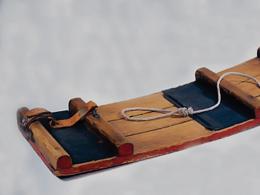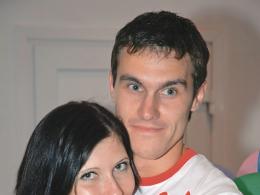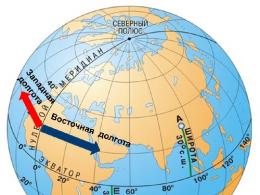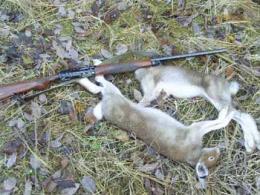Report: Winter sports. Snowboarding. History of snowboarding Post about snowboarding
Fans of active sports speak with admiration of snowboarding. Translated from English, this word means snow board. A snowboard is a special board for riding on mountain slopes. This sport is suitable for both professional athletes and beginners.
This sport is still quite young. The first mention of it in history dates back to 1939. The idea belongs to Vern Wicklun. He invented a sports equipment called the “Bunker”, the basis of which was an oak board with two pads for the legs. They were held in place by straps. Control was carried out by a rope tied in front of it. Vern built several of these sports equipment. The inventor himself and his friends, in their free time from work, rode on the mountain slopes on these “bunkers”. But the matter did not reach mass production of the first snowboard model.
In the sixties, Sherman Popen returned to this idea. This American, at home, built a projectile that resembled a snowboard for his daughter when he saw that she was going down the hill on a sled while standing.
The structure consisted of two interconnected skis and a rubber mat. This projectile could be controlled with a rope tied in front. It was called "Snerf". Other children were interested in this invention, so Sherman patented it and began mass production of Snerfs. The shell that went on sale cost $15.
New changes in the design of snowboards and their modernization were carried out in 1976 by Dmitry Milovich. He founded the Winterstick company, which began producing new models of sports equipment. Now it is a small enterprise producing handmade boards.
Due to the not very good handling of the first models, many ski resorts at that time banned their use. But manufacturers began to invent improved equipment. Skiing techniques have improved, which has contributed to the widespread popularity of snowboarding.
The first world championship among professionals was held in 1988; among juniors it took place in 1997 in Corno alle Scale (Italy). It acquired the status of an Olympic winter sport in 1998.
Disciplines in snowboarding
Snowboarding is divided into two groups, which differ from each other. The first includes freestyle disciplines, which involves performing acrobatic tricks on a board, and the second includes racing. Each of them is characterized by certain specifics.
Some disciplines are officially recognized. They are included in the programs of many competitions. Others are just beginning to develop. As such, there is no evaluation criterion for them yet.
Recognized disciplines
These include disciplines participating in high-level sports competitions, in particular the Olympics:
- Parallel slalom was included in the list of Olympic games, but in 2015, in accordance with the decision of the executive committee, it was excluded. The task of two athletes participating in a race is to overcome parallel tracks. Victory goes to the one who covers the distance first.
- Parallel giant slalom - covering a course marked with gates in the shortest period of time.
- Snowboard cross - overcoming a wide, gentle slope with various obstacles installed.
- Halfpipe - an athlete performs various tricks on a board at the moment when he flies out of the halfpipe (more precisely, from its vertical part).
- Slopestyle - covering a track while simultaneously performing tricks on equipment installed along the slope.
- Big air - an acrobatic trick is performed with a long long jump.
Unrecognized disciplines
Jibbing is becoming very popular. But this discipline is not on the FIS list. It does not belong to the recognized sports registered in the list of the Russian Federation, therefore there are no uniform rules and evaluation criteria for jibbing riders.
Competitions
Snowboarding is included in the program of top-level sports:
- Winter Olympics;
- World Championship;
- World Cup;
- US Open;
- X-Games.
Thanks to television, competitions can be broadcast anywhere in the world.
What is a snowboard directionand what types are there?
Types of snowboard destinations:
- Freestyle is practically an acrobatic direction. While riding, the athlete is required to perform tricks: spins, jumps, somersaults and other elements. Here the degree of complexity and skill of the techniques performed are graded. Passing speed is not taken into account. Freestyle elements are used in snowboard cross, big air, halfpipe, jibbing, and slopestyle.
- Hard snowboard (carving). The main requirement is to complete the route at maximum speed. Hard snowboarding techniques are used for snowboard cross, parallel slalom and parallel giant slalom.
- Freeride as a direction involves the conquest of undeveloped mountain peaks and slopes, virgin snow. It is considered the most extreme and dangerous. To ride on undeveloped terrain, you need precise calculation, unprecedented skill, and courage. Not every athlete can participate in freeride competitions. This requires special training. Judges evaluate the route chosen by the rider, confidence in passing the route, descent technique, presence or absence of falls and other technical data. Its main subtypes are: full ride, all mountain - conquering unprepared slopes and tracks and performing tricks, backcountry - walking up to a wild peak and descending. Also heliboarding - ascent and descent using a helicopter, snowcatskiing - a direction where a snowcat is used as a means of moving to the top and to the foot of the mountain. Heli-skiing is skiing on hard-to-reach slopes covered with virgin snow. The most dangerous type of skating is extreme skating, when an athlete rides at extreme speeds in places where conditions allow and where they do not.
- Jibbing is a direction where any slippery surfaces are used for skating, just not snow: railings, slats and other figures. This variety and freestyle have the same equipment. To prevent the edges of the sports board from catching when sliding, they are ground down.
- An adaptive snowboard is its modified form, where technical standards, rules, and equipment are adapted to the category of persons with disabilities. This allows them to restore their health and physical strength at a recreational level, and also participate in competitions. For the first time, its representatives participated in the Winter Paralympics in 2014.
Snowboarding equipment
A snowboarder's equipment set consists of the following items:
- Boards (snowboards) are of a multilayer structure, the lower part of which is framed by a metal edging.
- Special shoes to ensure a stable position of the feet and prevent injuries.
- Mounts to match your shoes.
- Helmet. It must be worn to protect the head from possible injuries.
- Gloves to protect the athlete’s hands from exposure to low temperatures and possible injuries.
- Masks. It should protect your eyes from ultraviolet rays, but prevent visibility from deteriorating.
- Multifunctional clothing. To do this, use thermal underwear and waterproof overalls.
- Cover to protect the projectile during transportation.
Snowboard performance
Selecting sports equipment is an important step for a snowboarder. Its parameters are also important.
Lenght and width
The size of the board depends on the height of the rider and its purpose:
- Universal (carving) - minus 15 cm from height. To independently determine a suitable snowboard, you need to place it near you. It is optimal if the top of the equipment reaches the chin, but not above the nose.
- For freeride training - minus 10 cm.
- For freestyle training - minus 8-10 cm.
Attention! If the weight is insignificant, another 5 cm is subtracted from the resulting figure. If the body weight exceeds the norm, 5 cm is added.
The websites of well-known brands of sports equipment contain tables for determining this parameter. In the form of a sticker, it can be attached to the inventory itself.
Important! You need to be especially careful when choosing a children's board. For training young riders, as well as for beginners, a mini-board is offered, the characteristics of which meet certain requirements.
There are several types of snowboards regarding their width:
The width of the board must be selected according to the size of the foot. For size 44 you need to choose a medium or wide snowboard.
If the width is chosen correctly, the athlete is able to control the edges of the projectile and prevent unwanted skidding, protecting part of the tail and nose.
Weight
Considering the design and fastening model, the weight of the board is 4-6 kg. It is enhanced by metal fasteners. A rigid board also weighs more.
Designs and materials
Manufacturers offer two main types of designs and their combination:
Snowboard deflection
Sports equipment is manufactured with the following types of deflections:
- weight (classical) - raised middle part;
- “Rocker” - arched with raised ends and a middle part touching the surface;
- zero - with an absolutely flat central part and raised ends;
- with combined deflection.
The combination of curves makes it easier for the rider to control the board at high speed.
Edges
For safety during sharp turns, the projectile is provided with narrow metal strips (edges).
As a rule, a straight edge is used. A long element is installed around the perimeter of the entire board. In its shortened form, it is absent in the front and back. This type is used in freeride.
A special offer from the Mervin brand Magne Traction is a wavy stripe that protects the snowboard.
Geometry
Depending on the position of the steel mounting holes, snowboards are:
- directional - with offset mortgages;
- twin type - with a symmetrical arrangement of holes;
- directional twin-type - with a slight displacement of the inserts and a difference in the stiffness index in the tail and nose.
Popular brands
Flow is one of the world leaders in the production of professional snowboards. Every year its employees develop and modernize new projects, they are tested and new model ranges are replenished.
The Burton brand, which is the founder of snowboarding, has gone through different stages of its activity throughout its existence, but the result has been global popularity. Burton Process is a popular model this season. Its high cost is fully justified on mountain trails.
The Austrian brand Head is one of the recognized leaders producing premium sports equipment for winter sports.
People who are interested in snowboarding talk about it as an exciting sport. To confidently stand on the equipment, special training is required. It will help prevent the appearance of pain, fatigue, and injuries, and the skating itself will only bring pleasure.
What is a snowboard? This is a board designed so that an athlete can ride it down a slope or mountain. But you can ride in different ways, and therefore the design and materials of the snowboard are very diverse, but at the same time, they all have a sliding base on one side and foot bindings on the other. Also, all boards have a metal edge along the edge, with which the athlete controls this sports equipment.
But snowboarding did not appear immediately in the form in which we know it today. It has come a long way, and the history of snowboarding itself is worth learning about.
1929
The history of snowboarding began in the 29th year of the last century, which was made by a certain Jack Burchet. The unusual thing about this event was that instead of the usual skis, he used a wooden sheet, which he controlled with a rope. No one knows why he did this, and his decision to register this action leaves even more questions.

1939
This year, Vern Wiklund showed the world a new invention, which he called the “bunker”. It consisted of a board with pads for the feet. There were also belts that acted as foot fastenings, and the board itself was made of oak and had a significant bend. A rope was attached to the bow of this structure, which, like reins, could be used to control the “bunker.” After the first model, 4 more modifications followed, which, unfortunately, did not make it into mass production. Their role was limited to entertaining descents for the inventor and his friends.
1963
Tom Sims, a young student at an American school, designed and defended a project for a board for descending snowy slopes, which was called a “skiboard.”
1965
A few years later, another step was taken towards creating a real snowboard. This year, in an attempt to spice up his daughter's holiday, Sherman Poppen connected ski runners and installed a binding with a rope in front. He even gave his creation a name - “snurfer”. The father’s efforts were not in vain; the daughter was delighted and hurried to show it to her friends. They, too, were amazed at the fun they had while riding a snurfer, and the hobby began to spread among young people. And Poppen decided to patent the invention and soon gave the right to produce “snurfers” to the Brunswick company.
The decision was more than successful, because in less than a year the athletes bought about 500,000 boards. In the same year, the first “snurfer” competitions were held, which were organized by Brunswick in order to generate sales.
1970
But the direct ancestor of the snowboard was not the snurfer. History has prepared this role for the invention of Dimitri Milovich - a surf-shaped board, which had traces of belonging to ski slalom and metal edgings along the edges.
1972
Bob Webber receives a patent for a "skiboard" he invented himself.
1975
Dimitri Milovich was able to organize mass production of snowboards. The production facility was located in Utah, and boards bearing the Winterstick logo were produced here. By that time, he abandoned metal edges, because Milovich practiced in virgin lands, where edges were simply not needed. He also patented the dovetail snowboard shape.

1976
Milovich realized that the use of metal edges was necessary and received a patent for a board with them.
1977
Jack Barton began creating a snowboard that would later be named after him, and Bob Webber used a polyethylene base for a board that was called the "Yellow Banana". The banana idea was taken up and developed by Tommy Sims, who supplied him with a skateboarding deck. The end of this year saw Sims launch skiboards.
That same year, inventor Mike Olsen completed the creation of his version of a snowboard, which he improved over the next 7 years - all the time he studied in college. Upon graduation, he wasted no time in opening the GNU company, which specialized in the production of snowboards.
1979
At the now regular competitions among snurfers, Jack Barton applied to participate on his own sports equipment, which was a board with rubber fastenings. At first the organizers did not allow him, but many participants wanted to compete with Barton and their voice broke the stubbornness of the competition organizers.

The same championship will remain in history for the fact that the first tricks on a snowboard were performed there. A certain Paul Graves, a professional rider from the Snurfer company, performed 4 full rotations, and at the end of the descent he dropped to one knee and incredibly impressively jumped off the board, which aroused the admiration of the audience.
The first halfpipe was built in '79, and this U-shaped tube caused a furor among journalists, who first announced the birth of the sport of snowboarding.
1980
At that time, developments in the field of snowboarding were carried out in parallel by two companies - Burton and Winterstick. And they led to the idea of using ski production technology in the development.
1982
Paul Graves, mentioned above, establishes the first snowboarding championship. The name chosen for it was quite original - “Surface”, and the competitions themselves took place in slalom and. The winner of this event was Tommy Sims, who won quite enchantingly - having taken the first prize, he crossed the finish line, crashed into the limiter and broke his finger. Well, Doug Barton turned out to be the best in terms of total indicators.
1983
At this time, snowboard bindings with a high back appeared. The invention was patented by Jeff Grell and Louis Fornier.

1985
Three significant events occurred in 1985. The first is the final focus on alpine skiing by the largest companies Sims and Burton. They abandoned surf-oriented boards and began equipping snowboards with metal edges. Secondly, a freestyle board with a rounded tail saw the light of day. Third, the first carving board appeared, released by GNU.
And the first magazine entirely dedicated to snowboarding was published.
1986
European snowboarding was born. At this time, the first competitions took place in Switzerland, the film “The Snow of Judgment” was released, full of daring on the boards.
1994
A triumphant hour for snowboarding - from now on it has become a discipline of the Olympic Games.
1998
Since 1998, snowboarders have been assigned the role of “bad guys,” and all because of the scandal surrounding Olympic champion Ross Rebagliati. Traces of marijuana use were found in his blood. However, they were weak and the athlete got out of it, explaining by accidentally inhaling smoke at a party.

year 2000
In the USA, snowboarding is becoming the most popular sport. It is ahead of alpine skiing in terms of the growth rate of adherents, which amounted to 51% per year versus 6%. The total number of snowboarders in the United States was approximately 7 million. In the same year, the first boards began to appear in the CIS.
Conclusion
Snowboarding is an exciting activity that, in just under a hundred years, has grown from children's entertainment to an Olympic sport. The history of snowboarding has never seen any falls; riding techniques and equipment have been continuously improved and continue to improve.
Snowboarding (from the English snow - snow and board - board) is a sport and active recreation that involves descending from a snow-covered slope of varying degrees of difficulty on a special board for riding - a snowboard.
Currently, there are a large number of varieties of snowboarding, focused on different route techniques and the nature of the slopes/snow. Some of these areas are included in the program of the Olympic Games and occupy a strong place in the modern classification of sports disciplines.
Snowboarding is a winter sport because it requires snow. However, some inventive teams also practice the summer version of skiing on sand dunes. This direction is called sandboarding.

The history of board skating.
The history of snowboarding as a separate type of skiing began in America in the mid-1960s. Surfer Sherman Popper designed a toy for his daughter in the image and likeness of a surfboard, only for riding in the snow. It consisted of two skis tied together. There were no fastenings for the legs in Popper's invention, so the “board” was controlled using a cable attached to its front edge.
Then the thing was called “snerfer”, from the English snow and surf, and the new type of active recreation, accordingly, was dubbed “snerfing”. The idea caught on very quickly, and within a year mass production of snurfers was launched.
In 1969, the first world snurfing championship was organized there, in the USA. One of the participants, Jake Burton, decided to slightly improve his equipment by placing leg attachments on the board. He was admitted to the competition, which means this date can be considered the moment of the birth of snowboarding in its classic, familiar form. Burton subsequently founded his own snowboard manufacturing company.
The rise in popularity of the new sport led to its official recognition and the establishment of the Snowboard World Cup in 1985 in Austria. At the same time, the International Snowboard Association was created, but it did not take root as an official body.
Currently, after only 50 years, snowboarding in all its diversity is included in the program of sports competitions of the highest level: the Olympic Games, US Open, X-Games and many others. The World Championship and World Cup are held in this discipline. The International Ski Federation has been appointed as the official body supervising snowboarding.
Types of snowboarding:
Since boarding is mainly a youth hobby, fans of this sport and leisure never tire of coming up with more and more new varieties. Below we will look at the 4 main subtypes of snowboarding:

Slalom is the passage of a course at speed along a given trajectory. Compliance with the trajectory is determined by flags placed along the route. The athlete with the best descent time wins. Slalom can be either single or parallel, when two participants descend at the same time.

Freestyle is based on performing various tricks while skating. These include jumping on trampolines and overcoming obstacles, as well as various technical tricks directly on the slope. At competitions, the athlete’s performance is assessed by judges, that is, subjectively.

Freeride snowboarding, like alpine skiing, is skiing on untouched snow, that is, outside the ski resorts and specially equipped and prepared routes and tracks. It is believed that it is freeride that gives the real feeling of the board and the slope, but at the same time it also promises a lot of dangers.
Halfpipe - riding a board on an elongated snow ramp while performing jumps and various tricks. Included in the Olympic Games program since 1998.
Anyone can try themselves in a modern and popular sport - snowboarding. All you need is a board, a pair of boots and a friend to teach you the basics. And forward to the slope!
Snowboarding can rightfully be considered one of the most popular and dynamically developing. Literally from English snowboarding is translated as snow board. Today it is difficult to find a person who has never heard of him.
Snowboarding is one of the most spectacular sports
Snowboarding is becoming a favorite winter pastime for those who love active recreation. This is drive, adrenaline and a sea of positive emotions for active people. However, this is only possible for lovers of winter active recreation only in winter. Experienced extreme sports enthusiasts and athletes consider it possible to use this type of sports equipment at any time of the year. This can be regular snow or artificial snow cover. In addition, some types of snowboarding involve riding on railings or other special figures. Thus, it is more correct to say that snowboarding is movement in space using a snowboard.
Modern trends in snowboarding
In total, there are several main areas: high-speed sports disciplines, freestyle, freeride, jibbing.
Sports disciplines
Among the sports disciplines, slalom and snowboard cross should be highlighted.
- Slalom is a high-speed descent along a mountain track, which includes ascents, descents, and sections of the route of different widths.
Depending on the length of the route and turns, the following are distinguished:
- traditional slalom (the course is the shortest, but at the same time false, winding, with steep turns, on which riders must demonstrate all their riding technique and skill);
- - the route is longer (up to 1 km), but less winding and difficult;
- super giant is the fastest of the tracks, where riders accelerate to 100 km/h.
- snowboard cross is a downhill race along a long (up to 2 km) and wide (up to 30 m) track, on which up to 6 athletes compete simultaneously. The track has turns. On it, athletes must show not only speed. They must correctly overcome various obstacles, perform jumps and turns.

Freestyle
The current direction in snowboarding can be considered acrobatic. On the descent, the athlete demonstrates: these are various jumps, rotations, somersaults, etc. Here everything is done, rather, not on the speed of passing, but on the skill and level of complexity of performing a particular technique.
In freestyle, the following subspecies are distinguished:
- Halfpipe - skiing downhill in the form of a deep channel of hard snow. Outwardly, it resembles a longitudinally cut pipe. The height of the edges of the gutter is from 3 to 4 m, the length is 100 m, the angle of inclination is 15–20 degrees. The rider rides from one edge of the chute to the other, flies out in a radius while performing various types of tricks, and lands on the second edge of the chute. It looks very similar to skateboarding or roller skating on a ramp.
- Big air is an accelerating jump from a springboard. Marks at competitions are given for the complexity of the jump, amplitude, and clarity of the tricks. The cleanliness and clarity of the landing is also taken into account.
- Slopestyle - skiing on a route with parallel figures.
Freeride
This direction involves skiing on undeveloped mountain slopes and peaks, on virgin snow. This is the most risky and extreme type of snowboarding. Skiing on undeveloped slopes requires unprecedented skill, precise calculation and, of course, courage. Competitions in this type are also held, but not all athletes are invited here. Here the route chosen by the rider, descent technique, confidence on the route, falls or lack thereof, etc. are assessed.
Jibbing
This type involves riding in snowboarding parks using special figures. These can be slats, railings or any other shapes.
History of the origin and development of snowboarding
For the first time, riding a board, somewhat similar to a snowboard, was mentioned at the beginning of the 19th century. D. Berchet made the first board from an ordinary piece of plywood back in 1929. However, the official history of snowboarding began only a little more than half a century ago. The founder is considered to be surfer S. Poppen. It was he who came up with a new activity. He connected both skis together, and tied a rope in front to control them and hold the skier. Poppen called his sports equipment “snurf” and in 1965 received an author’s certificate for it. He soon transferred the patent to a company that was engaged in the manufacture of sporting goods and equipment. At the end of the current decade, there was already a well-established production of snurfs and even the first competitions were held.
In the early 70s, a board more similar to the modern one appeared. The improvement was carried out by T. Sims, D. Burton, C. Barfoot. They created a high heel counter and a rounded back at the board. The edging was changed to metal.

By the end of the 70s, the popularity of this sport began to increase, many companies producing snowboarding boards appeared, and they began to be advertised on television. However, popularization did not occur as easily as expected. At that time, there were no special tracks for snowboarding, and riders were simply not allowed on the ski slopes. According to one version, it was then that one of the branches in the direction of snowboarding was born - freeride, since athletes had to ride not on a well-equipped mountain slope, but on virgin soil.
The situation changed by the mid-80s. On some ski slopes, due to the increasing demand for this sport, riders began not only to be allowed on the slopes, but also to conduct special courses for those who want to learn how to ride a board. The first printed snowboarding guides appeared. The first championships in Europe also began to be held, and in the late 80s the World Cup was held.
Over the next decade, snowboarding as a sport developed very dynamically, and new riding styles began to appear. The number of people wishing to go down the mountain slope on a board grew every year. If before this the main winter entertainment was skiing, which was preferred, as a rule, only by select and older people, then by the end of the 90s it began to be slowly replaced by more youthful and democratic snowboarding. By the end of the 90s, snowboarding received Olympic status. For the first time in 1999, snowboarding competitions took place at the Winter Olympics in Nagano. Not all of the previously listed snowboarding disciplines were included in their program. Initially, in 1999, the program included four areas: women's and men's halfpipe and parallel giant slalom. A little later, snowboard cross competitions for men and women were also included.

From that time to the present day, snowboarding has been constantly and dynamically developing. In just over half a century, it has become the most popular winter sport. Today, snowboarding is chosen by almost a quarter of the world's inhabitants, with every sixth of them aged between 7 and 11 years.
Why do many people prefer this sport?
Snowboarding is one of the most exciting and driving sports. On the one hand, the descent itself is breathtaking, on the other hand, from the beauty of the surrounding nature, because snowboarding trails are always located in very picturesque places. Those who once tried it very rarely leave this activity. After all, it takes very little time for you to start descending on the board. A few sessions and you're already down the slope. In addition, a significant role is played by the wide selection and availability of equipment, the presence of different styles of skating, the opportunity to improve indefinitely, participation in various kinds of competitions and much more. This is a great way to exercise, because this sport requires the use of almost every muscle in your body.
Snowboarding is a great way to relax both body and soul. The audience is not important here, the most important thing here is the understanding that you did it, you were able to do it.
14.07.2019 17:35
Word " snowboarding" literally means "boarding in the snow." Snowboarding is a winter sport, so attracting its fans with thrills. Snowboarders on the board stand sideways towards the path of movement. The athlete's stance is especially important. The competitive programs included in snowboarding are divided into freestyle (scored) and slalom (timed).
IN slalom competitions held on mountain slopes, the winner is the one who covers the required distance faster. Parallel slalom involves two athletes starting at the same time on identical courses. While driving, their goal is to reach the finish line faster than their opponent. Competitions in this discipline consist of two stages: qualifying and final, at each of which the athlete has two attempts. The result is the total time in both attempts. Parallel slalom is a knockout system. If the results are the same, the athletes make an additional run.
Snowboardcross(or "bordercross") is a free descent performed on a track up to 2000 m long and 30 m wide. Snowboardcross competitions involve 4 or more people at the same time. Athletes make turns, jumps, and overcome obstacles on a special track.
Another type of snowboarding - freestyle- This is trick skating. It includes spins of varying difficulty, jumps, grabs, and somersaults. Freestyle can be considered a “subjective” sports discipline. The judges evaluate the technique and complexity of the elements, the beauty of their execution, and the amplitude of the jump.
There are several types of freestyle. Halfpipe- this is skating in a sloping chute made of snow, similar to a roller skate ramp. Quarterpipe And superpipe- similar types of freestyle, differing in the angle of inclination and width of the slope. Ski jumping – bigaire, imply the acceleration, jump and landing of the athlete. Slopestyle– these are competitions with figures in two or more rows on sections of the route.
Freeride called skiing on dangerous mountain slopes. This is the most extreme form of snowboarding. Only specially trained snowboarders with extensive riding experience take part in competitions using this riding technique.
To control a snowboard, athletes shift their body weight from their heels to their toes. To stop the movement, the snowboarder turns down the slope with his toes or heels so that the board absorbs the speed of movement when turning. Snowboarding is most similar to surfing and.
It’s hard to find a person who tried snowboarding once and gave up trying again with disappointment, although of course such people do exist. Over the past twenty years, snowboarding has developed rapidly.
Snowboarding offers many benefits:
- a variety of riding styles with an unlimited level of development of “driving” skills;
- scenic snowboarding trails around the world that will take your breath away;
- the opportunity to get a high surge of adrenaline on the descents when performing tricks;
- a huge selection of snowboarding equipment of various levels that contribute to the development of riding skills;
- short-term training, thanks to which you can enjoy riding within a couple of days from the start of training;
- a variety of methods, options and styles of skating;
- various types of trails from a well-groomed slope to “untamed” virgin snow;
- the opportunity to participate in competitions at any level;
- hundreds of thousands of like-minded people who share your hobby.
Just imagine: you are rolling down a slope, the wind is blowing on your face, your body is filled with adrenaline, and the idea of conquering a new peak flashes through your thoughts. This is truly wonderful. Check it out for yourself. Happy flights and soft landings on the “snow board”!






